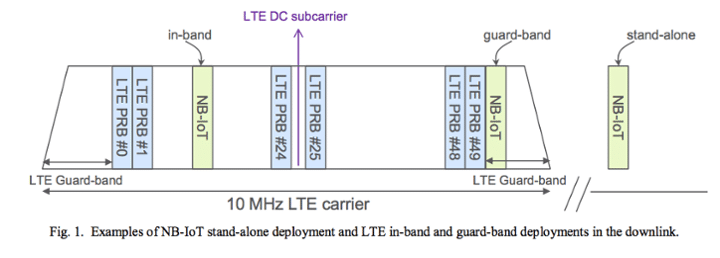Narrow Band IoT (NB-IoT) is a Low Power Wide Area Network (LPWAN) radio technology standard that has been developed to enable a wide range of devices and services to be connected using cellular telecommunications bands. NB-IoT is a narrowband radio technology designed for the Internet of Things (IoT), and is one of a range of Mobile IoT (MIoT) technologies standardized by the 3rd Generation Partnership Project (3GPP). Other 3GPP IoT technologies include eMTC (enhanced Machine-Type Communication) and EC-GSM-IoT. The NB-IoT specification was frozen at Release 13 of the 3GPP specification (LTE-Advanced Pro), in June 2016.
NB-IoT focuses specifically on indoor coverage, low cost, long battery life, and enabling a large number of connected devices. The NB-IoT technology can either be deployed “in-band” in spectrum allocated to Long Term Evolution (LTE)—utilizing resource blocks within a normal LTE carrier, or in the unused resource blocks within a LTE carrier’sguard-band—or “standalone” for deployments in dedicated spectrum. It is also suitable for the re-farming of GSM spectrum.
| LTE Cat 1 | LTE Cat 0 | LTE Cat M1
(eMTC) |
LTE Cat NB1
(NB-IoT) |
EC-GSM-IoT | |
| 3GPP Release | Release 8 | Release 12 | Release 13 | Release 13 | |
| Downlink Peak Rate | 10 Mbps | 1 Mbps | 1 Mbps | 250 kbps | 14 kbps |
| Uplink Peak Rate | 5 Mbps | 1 Mbps | 1 Mbps | 250 kbps (multi-tone)
20 kbps (single-tone) |
|
| Latency | 50-100ms | not deployed | – | 1.6s-10s | 700ms-2s |
| Number of Antennas | 2 | 1 | 1 | 1 | 1 |
| Duplex Mode | Full Duplex | Full or Half Duplex | Full or Half Duplex | Half Duplex | |
| Device Receive Bandwidth | 1.08 – 18 MHz | 1.08 – 18 MHz | 1.08 MHz | 180 kHz | |
| Receiver Chains | 2 (MIMO) | 1 (SISO) | 1 (SISO) | 1 (SISO) | ? |
| Device Transmit Power | 23 dBm | 23 dBm | 20 / 23 dBm | 20 / 23 dBm |
3GPP specification for NB-IOT has two competing variants, Huawei/Vodafone vs. Erikson/Nokia/Intel. Additionally, Erikson has stated that older 4G infrastructure based on Alcatel will not be backwards compatible with NB-IOT. This means that thousands of base stations would have to be changed in the US for carriers to support NB-IOT. In light of that, most US Based carriers will stick to LTE-M.
So NB-IOT will be for simple devices that need to connect to an operator network via licensed spectrum. It is not available yet, and will likely not be until the end of 2017, and even later in the US. If you follow the company Sigfox, you will recognize this as the 3GPP community’s attempt to address the market space created by networks like Sigfox.
 As an intelligent and smart lighting solution provider, uPowerTek is working on NB-IOT as well as PLC, WIFI and Bluetooth which are usually for small network connections. For outdoor lighting projects like street lights, NBIOT could be a better solution.
As an intelligent and smart lighting solution provider, uPowerTek is working on NB-IOT as well as PLC, WIFI and Bluetooth which are usually for small network connections. For outdoor lighting projects like street lights, NBIOT could be a better solution.





